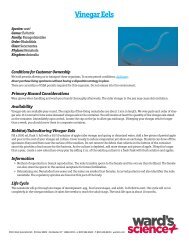WS_HSE_Catalog_VWR_new - Ward's Science
WS_HSE_Catalog_VWR_new - Ward's Science
WS_HSE_Catalog_VWR_new - Ward's Science
Create successful ePaper yourself
Turn your PDF publications into a flip-book with our unique Google optimized e-Paper software.
58 models | human pathology<br />
Obesity Model<br />
Shows Two Common Fat Distribution Patterns<br />
With an increased emphasis on obesity prevention in education, this<br />
model demonstrates the negative effects of excessive weight gain. Both<br />
pear and apple shaped bodies are shown in two cross-sections of the<br />
hip area. Rach model illustrates effects from obesity, such as compression<br />
from viseral fat on the colon, common iliac artery and veins, ureter, small<br />
intestine, femoral nerve, and more. The pear body fat distribution pattern<br />
is referred to as lower body fat, mainly composed of subcutaneous fat. The<br />
apple body fat distribution pattern or intra-abdominal fat can be composed<br />
of both visceral and subcutaneous fat. Contrast a non-obese body to<br />
the pear and apple fat distribution in both internal and external structures<br />
on the included informational key card. Model Size: Pear: 4 1 /8" x 5 3 /8" x 3 1 /2".<br />
Apple: 3 3 /4" x 5 3 /4" x 3 1 /2".<br />
810978 $106.00<br />
Type II Diabetes Models<br />
Demonstrate Relationship Between<br />
Diabetes and Its Effects<br />
Miniature replications of the human brain, eye, heart, kidney, artery,<br />
pancreas, neuron, and foot illustrate the effects associated with<br />
Type II Diabetes. Show students the potential physical ailments<br />
associated with diabetes, including stroke, non-inflammatory disease<br />
of the retina, hypertensive heart disease, hardening of the<br />
kidney, hardening of the arteries, insulin resistance, neuropathy,<br />
and foot ulcerations. Includes informational key card. Size: 6 1 /2" x<br />
5" x 10".<br />
810973 $147.50<br />
Basic Skin Health Models<br />
Examine Three Common Skin Conditions and Pathologies<br />
The human body’s largest organ is shown in vivid detail through three models demonstrating the appearance of normal, healthy skin and skin<br />
afflicted with disorders, damage, or disease. All models allow you to analyze both the interior and exterior anatomy and characteristics of the<br />
skin. The Acne Model represents an enlarged cross-section of the skin with raised structures, detailing an acne pustule or pimple, a blackhead,<br />
and a whitehead. Also shown for basis of comparison are the epidermis, dermis, and subcutaneous tissue details of normal skin, including hair<br />
follicles. The Burn Model displays first, second, and third degree burns, revealing the increasing severity of damage to the skin’s layers. This twosided<br />
model uses the reverse side to illustrate normal skin anatomy. Three cancerous conditions and three non-cancerous conditions are shown<br />
in detail on the Skin Cancer Model. A nodular basal cell, malignant melanoma, morpheic basal cell, dyplastic nevi, keratoacanthoma, and actinic<br />
keratosis are presented with both basal layer and dermal layer cross-section detail. Each model includes an illustrated information card identifying<br />
the skin features shown. Size of each: acne model measures 4" dia. x 1 1 /4"H; burn measures 6"L x 2 1 /4"W x 4"H; cancer measures 4" dia. x 1 1 /4"H.<br />
810923 Acne $75.15<br />
810924 Burns $75.15<br />
810925 Cancer $75.15<br />
1.800.932.5000 | vwr.com





